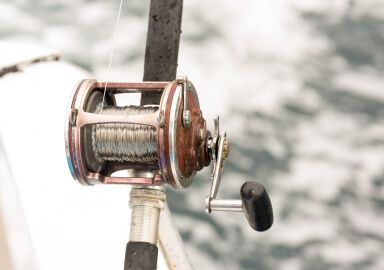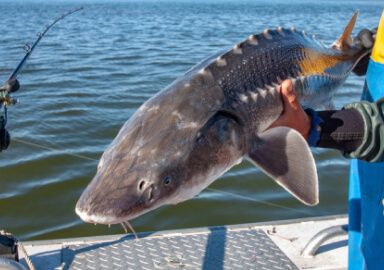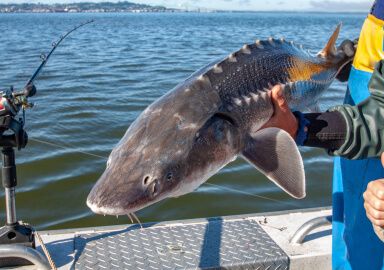Amu Darya Sturgeon
The Amu Darya sturgeon is a rare, threatened, fairly small fish species limited to some rivers that flow westwards into the Aral Sea.
View 1 listing
1
listings
–
price starting from
1
countries
–
to the nearest trip
About Amu Darya Sturgeon
The Amu Darya, or false shovelnose, sturgeon (Pseudoscaphirhynchus kaufmanni) is an endangered and intriguing member of the sturgeon family. While unmistakably a sturgeon, this fish differs from all other members of this family by a long filamentous extension to its tailfin. Unlike most other sturgeons, the Amu Darya sturgeon also has a broad, flattened, head. There are two recognised morphs of this species, a lighter coloured one that grows large and matures late, and a darker one that is smaller and matures earlier.
The Amu Darya sturgeon is generally light grey or blue above, paler below. As usual for sturgeons, they have large white scutes along the back; otherwise, the skin is leathery. The mouth is small and located under the head. They can grow to 75 cm (30 in.) and 2 kilograms (4.4 lbs) and are thought to live for up to about 14 years, maturing at about 5-8 years of age. Amu Darya sturgeon mostly invertebrates when young, and gravitate to a predominantly fish diet with age. They live mostly in turbid, muddy rivers and estuaries and may undergo an upstream spawning run in spring, but some studies suggest each individual may do it only once in four or five years.
How to Catch?
As Amu Darya sturgeon is a critically endangered species, recreational fishing is very limited, although this fish remains an important food source for local people and, despite the declining distribution and numbers, local fishers continue to catch as much as they can. Due to the peculiarities of the fish, and also the difficulties of accessing and travelling in the countries in which it is found, it is best to contact one of the international operators that offer fishing for this species. They are able to give guidance on where, when and how to catch this species and also ensure the safety of the angler and avoid misunderstandings with local people and authorities. They can also usually supply suitable equipment to target this species.
While the methods to catch the Amu Darya sturgeon are similar to those for other sturgeon, the tackle can be lighter as the species does not grow exceptionally large. Despite its conservation status and difficulties in getting to where it is found this species is fascinating and, if you succeed, you will be one of the very few recreational anglers who have managed to catch this unique fish.
Similar Species
Amu Darya sturgeon used to be widespread and fairly common throughout the Amu Darya River basin and the Aral Sea. In recent years through heavy fishing pressure, agricultural development, and pollution it is now restricted to the middle reaches of a few tributaries and the Amu Darya river itself in parts of Turkmenistan, Uzbekistan, Tajikistan and possibly Afghanistan. The Amu Darya sturgeon is a fish of arid areas. Like many sturgeon species, it is relatively inactive in winter, making rod and line fishing difficult and unproductive but, as temperatures rise, so does its activity and feeding behaviour. In the rivers it is usually found in the deeper pools or below rapids, not in the fast current. Not all fish undergo the spawning migration each year, so there are always some mature fish throughout the remaining range of Amu Darya sturgeon.





